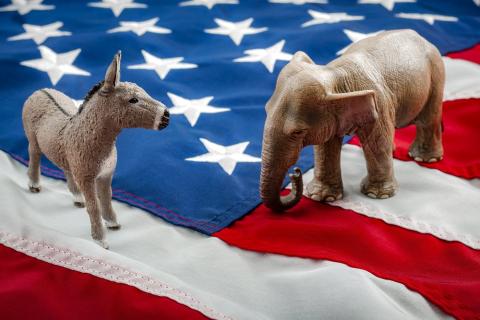Ever heard this joke? “American politics is like a highway of progress. Republicans stand on the right saying turn right, Democrats stand on the left saying turn left, and Independents stand in the middle, hopelessly waiting to be ran over.”
If you haven’t heard it, you have now, and you probably understand why people think it’s humorous.
Many believe the two-party system is the way for American politics, not a way. We’ve dealt with two parties for so long (and they’ve gamed the system for many years) that we can’t even imagine a different possibility.
The problem is, the argument for the current two-party system is an A-Priori fallacy.
Pose the question: “Why do we have to have a two party system in American politics?”
You’ll get a plethora of a-priori arguments as answers.
“It’s always been that way.”
“It’s the only thing that works.”
“We’re not Britain.”
Very rarely do you get an argument for the two-party system based on any form of statistics, facts, or logic.
The reality is, the tape tells a different tale. The people are clearly discontent with the two-party system.
A recent Marist poll conducted by NPR and PBS told quite the interesting tale. The facts are as follows:
- Out of registered voters identifying as DEMOCRAT, 27% answered they have “not very much confidence” in their party, and 3% answered they have“no confidence at all.”
- Out of registered voters identifying as REPUBLICAN, 31% answered they have “not very much confidence” in their party, and 2% answered they have “no confidence at all.”
- Thus, overall, 30% of registered DEMOCRATS, and 33% of registered REPUBLICANS have low confidence in their own party.
This is astonishing.
If more than 30% of the party’s registered voters distrust them, why in the world do they maintain affiliation and vote for them? It makes no sense, until you consider the A Priori fallacy mentioned above. Us voters simply think this is the way to govern, not a way.
Fortunately, we’re at a time when a solution is nigh. More and more voters are affiliating as independents, as shown by a 2014 Pew Research poll (Figure 1, below) in which 39% of respondents reported Independent affiliation.
And these Independents aren’t stranded in the middle of the road. There are plenty of viable independent candidates and worthy organizations popping up for them to support.
Some examples are:
- Unite America (formerly The Centrist Project) – An organization providing Independent candidates the backing of a party-like organization, without the nonsense. (Website / Facebook / Twitter)
- Independent Voter Network–The largest open news platform for independent-minded authors and readers, founded not on an ideology but a simple etiquette. IVN covers independent campaigns from across the country. (Website / Facebook / Twitter)
- Bill Walker – The current governor of Alaska. (Website / Facebook / Twitter)
- Terry Hayes – Currently the State Treasurer for Maine and a candidate for Governor of Maine in 2018. (Website / Facebook / Twitter)
- Greg Orman – Candidate for governor in Kansas. (Website / Facebook / Twitter)
- Bob Krist – A State Senator from Nebraska, running for Nebraska Governor. (Website / Facebook /Twitter / FWM Interview)
If the discontent voters mentioned above can escape the matrix-esque world created by the parties and join those already identified as independents, these candidates and organizations would have voter support that could greatly change American politics.
Independents would make up 57% of registered voters; that’s an incredible amount of influence.
So, if you’re one of the discontent, this is your red pill. Break out of the fallacy, disaffiliate, and start supporting independent candidates and organizations near you.
If you’re one of the independent candidates or organizations, increase the distribution of red pills. Educate and motivate voters on the new and improved method of governance and how to achieve it.
It’s time we let the voters control our government — not the parties.
© 2018 by Free Wheel Media. The article originally published on FreeWheelUs and has been republished by request and with permission from Free Wheel Media.

